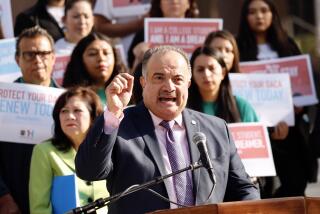Pierce Could Be Left With Only Enough to Pay Staff : Budgets: The Woodland Hills college president says, if a $2.8-million reduction is approved, there would be no money for maintenance, supplies or utilities.
If $2.8 million in budget cuts proposed for Pierce College are approved, the school could pay the salaries of its existing faculty and staff, but would have no money left for anything else.
That’s how President Lowell Erickson explained the effect of a preliminary budget unveiled last week by Los Angeles Community College District officials.
“Our personnel expenses for this year about total the amount of money they’re giving us next year,” Erickson said. “There would not be one red cent remaining for utilities, maintenance, supplies or other things it takes to run a college.”
The proposed budget hits the Woodland Hills school harder than any other college in the nine-campus district. The spending plan, which Vice Chancellor Neil Yoneji called “very preliminary,” includes cuts for all nine colleges--ranging from a high of 11.6% for Pierce to a low of 5.1% for Trade Technical College in downtown Los Angeles.
Reductions proposed for the district’s two other San Fernando Valley colleges are 5.9%--or $1.3 million--for Valley College in Van Nuys and 6.1%--or $526,000--for smaller Mission College in Sylmar. The presidents of both those schools said they would have trouble making ends meet in the 1993-94 school year.
Mission College President Jack Fujimoto said cutting $526,000 from the budget would be “like wiping out all the hourly instruction for one semester.”
Valley College President Mary Lee said, “Everybody will have a say,” that students, staff, faculty and administrators will help decide how the college will balance its books.
Yoneji said the district’s spending plan reflects Gov. Pete Wilson’s proposed 11.1% decrease in state spending for community colleges contained in his budget message in early January. Overall, the proposed budget is down $11.3 million from this year’s $240.5-million spending plan.
The district also will dip into its reserve fund and refinance some loans to make up a $5.6-million shortfall from this year’s budget, Yoneji said.
Wilson said the colleges could offset some of the decrease in state funding if they triple fees for undergraduate students to $30 a unit and more than double fees for those who already have bachelor’s degrees to $130 a unit.
But trustees and district officials predicted that a raise in fees for the second straight year would drive more students away. Fees went up from $6 to $10 a unit for undergraduates and to $50 a unit for students with bachelor’s degrees this semester, and enrollment already is down 5% to 6% in the 115,000-student district, they said.
“When a fee increase is imposed in the inner city and major urban areas, it devastates the opportunity for students to attend school,” Chancellor Donald G. Phelps said last week.
At Pierce, officials said, enrollment is down about 5%, the same as the district overall. “We just didn’t get the new students we expected,” said William Norlund, Pierce’s vice president of academic affairs.
Erickson and the other presidents said they do not know just how they will cope with the shrinking funds. But personnel is one place Pierce may be forced to cut, he said.
Pierce spends about $2.2 million for part-time instructors, Erickson said. If they are eliminated, he said, the college also will have to reduce the number of credit and non-credit courses, which will cause enrollment to decrease even more.
“Our part-time instructors bring in between 30% and 40% of our total enrollment,” Erickson said.
With a drop that size, the district could lose about $10 million in state enrollment funds, he said, because funding is partly determined by the number of students attending an institution. As enrollment drops, state funding declines; such declines, in turn, encourage enrollment to drop.
“There’s no way you can run a college handicapped like that,” Erickson said.
Erickson said Pierce will try to raise more funds on its own. One possibility is to lease a large unused portion of the school’s 200-acre farm for a revenue-producing concern such as a golf course.
That also would save the school money. “We estimate that the farm costs us about $200,000 a year just to maintain,” Erickson said.
Whatever the vacant land’s eventual use, it will be tied to education, he said.
For example, Erickson said, a golf course could be used in a variety of instructional programs, including agriculture, horticulture, turf management, physical education and property management.
However, he said, a golf course could not be opened in time to help with next year’s budget.
Nearby residents and Los Angeles City Councilwoman Joy Picus have long campaigned to preserve the farm as open space, and Picus has proposed changing the site’s zoning to achieve that goal. They also fear that the land could be sold off to developers who would build condominiums or office buildings.
Picus’ planning deputy, Jim Dawson, said the reason for the change was to make the farmland’s zoning compatible with the area’s community plan. The change was not introduced to make it more difficult for the college to make use of the land, he said.
But Erickson and others said they fear such a change might hamper the college’s efforts to lease out the land, even to a golf course operator.
Some residents probably would not object to a golf course, Erickson said, but others would.
“Some people just want it to stay open space,” he said. “I don’t see why our district should be required to provide the community’s open space. I don’t think a campus is an ‘open space.’ I see it as a location for educational activities.”
Dawson said the proposed zoning change probably will reach the City Council within two months.
At Mission College, Fujimoto said some part-time faculty and staff will probably be eliminated. In addition, he said, the school, which moved to its permanent campus two years ago, will not be able to complete its building program.
A classroom building, child-care center and other facilities will be put off indefinitely, he said.
“It really depends on where colleges want to put their priorities,” Fujimoto said of planning for budget cuts. “It’s a real dilemma.”
“There are some creative things we can do to save money,” said Valley College’s Lee.
For example, she said, an architect recently donated his time to draw up preliminary plans for a new classroom building at the college, and a private party donated $40,000 to the school, the interest on which is being used for scholarships.
Lee said she is pleased, however, with one element of the budget. In the past, Valley helped subsidize smaller colleges because it generated more money than it received from the district. Under the new budget, Pierce and L.A. City colleges will help Valley support the smaller schools under a new formula for distributing district funds.
“And next year, Trade Tech and East Los Angeles will contribute,” she said.
Trustees adopted the new formula after Valley’s students, staff and faculty complained that the college had contributed between $1 million and $2 million to less-profitable schools annually for the last 10 years.
More to Read
Sign up for Essential California
The most important California stories and recommendations in your inbox every morning.
You may occasionally receive promotional content from the Los Angeles Times.










